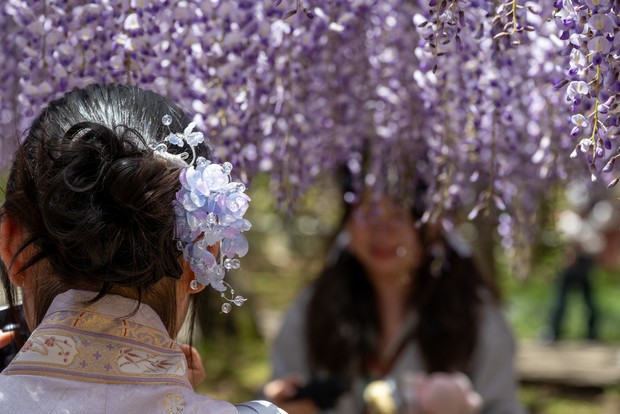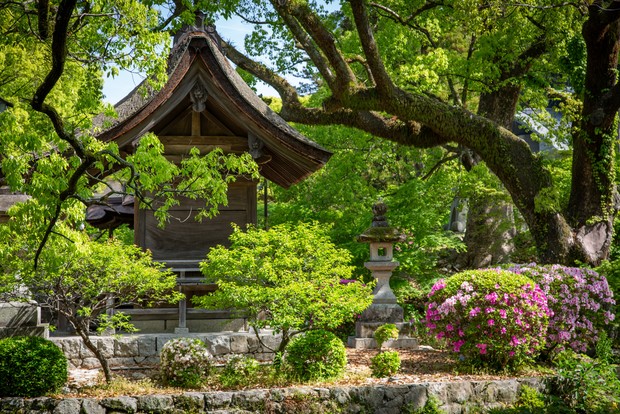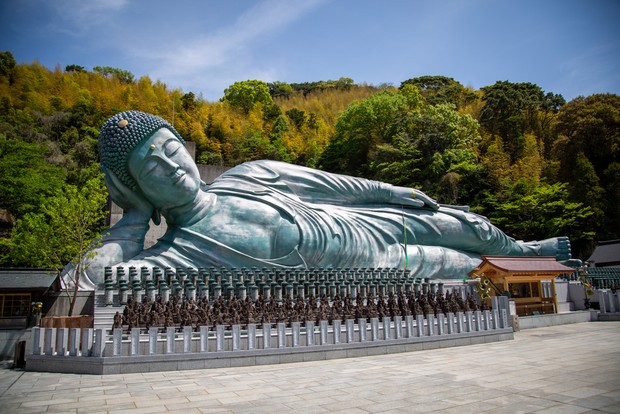30 Apr 2025
Blooming Wisteria in Fukuoka

We were greeted by the start of another lovely summer’s day as we docked at Hakata Port in Fukuoka and headed on our excursion of choice. We all drove through Fukuoka and Kokura cities, with a stretch of wooded hillsides in between, and visited the Kokura Castle, a truly impressive reconstruction of a feudal period citadel. We were welcomed by friendly samurai warriors and had a go at making our own strand of Kokura-Ori weaving. Lunch was a double-decker bento box with a wide assortment of local delicacies.
The other attractions of the day included Dazaifu Tenmangu Shrine which featured several smaller shrines and lovely gardens across the red arched bridge. We continued to Nanzoin Temple, to view the enormous brass reclining Buddha statue, one of the largest in the world. We entered to see a relic of one of the bones from The Buddha. For something completely different, we stopped at the TOTO Museum, being the makers of the famous Japanese toilets. Perhaps surprisingly, the “toilet museum” was fascinating, including a full rundown of the development of this essential part of everyday life, plus information on the company’s commitment to creating a sustainable society and outreach to support the improvement in hygiene in developing countries.
For some, a highlight of the day was the Kawachi Fujien Wisteria Garden. We were privileged to visit this garden near the peak season of the blooms. Our jaws dropped as the sea of vibrant flowers of many colours filled our eyes, and the sweet aroma filled our nostrils. We were carried along the tunnels of dripping blossoms in a convoy with many local people finding places for family or sweetheart photos, or to sit and enjoy. The gardeners among us all agreed that we had seen wisteria before in many places – but never anything like this. It was truly indescribable.
The local Tanga Market gave us another chance to mingle with the locals and to take home koi/carp streamers for our own versions of Children’s Day.
For others, a visit to the Ashiyagama no Sato Iron Works showed a slice of Edo Period technology as modern craftsmen recreated the feudal process of casting the delicate iron pots that were used to boil the water for the tea ceremony.
This was a very full day, but wasn’t over yet, as we remained at the dock for a barbeque dinner. The mild evening had us all on the aft deck with the lights of Hakata Port all around as we laughed and shared memories. It was a wonderful, multi-faceted, day.
Images © S. Bradley & J. Mishina, Heritage Expeditions


We could see the quirky city skyline and the hills surrounding Nagasaki as we arrived for our excursions. For some, the first destination was the …READ MORE
Yakushima Island is the wettest part of Japan, so it was not a surprise to look out the window as we reached the port. Still, you can’t have …READ MORE
Our arrival at Uwajima Port was met by a fantastic welcoming committee, including two young girls in kimonos. Our golden weather continued as we se…READ MORE









